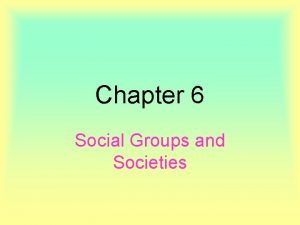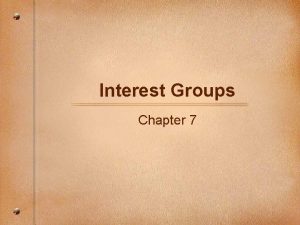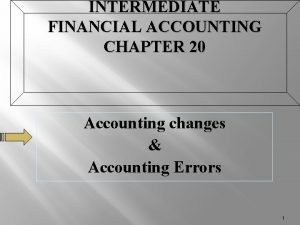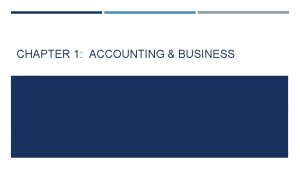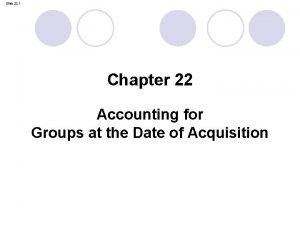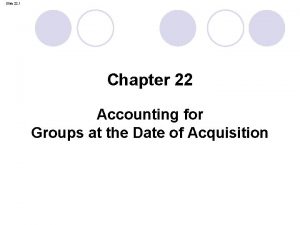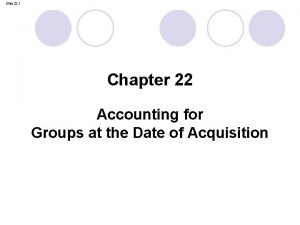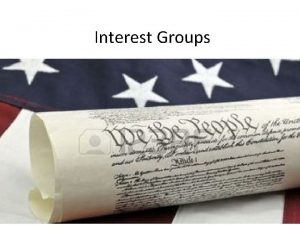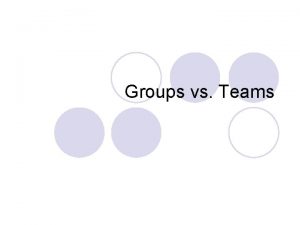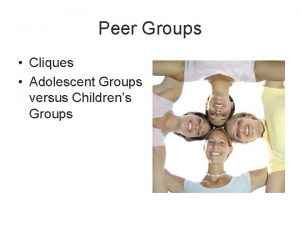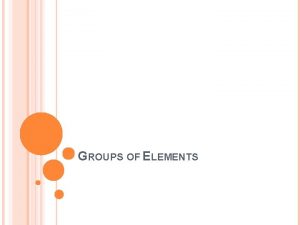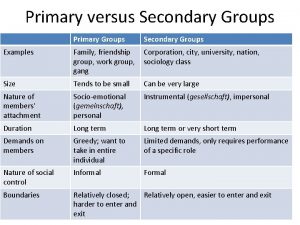Slide 22 1 Chapter 22 Accounting for Groups















































- Slides: 47

Slide 22. 1 Chapter 22 Accounting for Groups at the Date of Acquisition

Slide 22. 2 Global companies form groups

Slide 22. 3 Main purpose There is a need to see the overall results of a group not only that of its individual companies. The main purpose of this chapter is to explain the reasons for preparing consolidated financial statements at the date of acquisition and to show to prepare such statements.

Slide 22. 4 Objectives By the end of this chapter, you should be able to: • explain the need for consolidated financial statements; • define the meaning of IFRS 10 terms ‘control’ and ‘subsidiary’; • prepare consolidated accounts at the date of acquisition and calculate goodwill for a wholly-owned subsidiary; • explain the treatment of goodwill; • account for non-controlling interests under the two options available in IFRS 3; • understand the need for fair value adjustments and prepare consolidated financial statements reflecting such adjustments.

Slide 22. 5 Group accounts framework IAS 27 Separate financial statements l IAS 28 Investments in associates l IFRS 3 Business combinations l IFRS 10 Consolidated financial statements l IFRS 11 Joint arrangements l IFRS 12 Disclosure of interest in other entities l IFRS 36 Impairment of assets l

Slide 22. 6 Accounting for groups at date of acquisition • Definition of a group under IFRS 10 • Definition of control: – rights to variable returns – ability to affect those returns – through power over the investee • Reasons for preparing consolidated accounts.

Slide 22. 7 How is a parent-subsidiary relationship identified? l Parent l Controls Forms a group l Subsidiary l l IAS 27 defines consolidated financial statements as ‘the financial statements of a group presented as those of a single economic entity. ’ l A group is made up of a parent and its subsidiary. l We will focus on enterprises, i. e. companies

Slide 22. 8 Definition of a group • One enterprise controls another enterprise – Directly – Indirectly.

Slide 22. 9 Direct control l Company A owns 70% of the issued capital of Company B This would be expected to lead to Company A having control of B directly. Company A's 70% voting interest in Company B will also amount to a 70% beneficial interest in the profits being generated by Company B

Slide 22. 10 Indirect control l Company A has control of Company C by virtue of its control of Company B - this form of control would be considered to be indirect control. Compamy A’s beneficial interest in C is 45% (70% of 60% = 45%)

Slide 22. 11 Indirect control l Control of another entity may also be achieved through a combination of direct and indirect ownership interests. Company A has direct voting interests in Company C of 40%, as well as indirectly controlling 25% of the voting interests through its control of Company B. The economic control would be considered to be constituted by all three companies. Company A's beneficial interest in Company C would be 40%, plus 65% of 25%, which amounts to 56. 25% in total.

Slide 22. 12 What is meant by control? IFRS 10 l Control is the power to govern the financial and operating policies of an entity so as to obtain benefits from its activities.

Slide 22. 13 Control = Power over more than 50% of the voting rights by virtue of agreement with other investors holds <50% of the voting rights, but the remainder are widely distributed to govern the financial and operating policies to cast the majority of the votes at meetings of the board of directors. to appoint or remove the majority of the members of the board of directors

Slide 22. 14 Reasons for preparing consolidated accounts l Because many corporations have controlling interests in other business entities, financial statements for the parent company alone can be misleading. For this reason, parent companies are legally required to prepare consolidated financial statements that include data about the financial performance of subsidiaries l Prevent manipulation ¡ Inflating sales by selling within the group ¡ More meaningful EPS figure ¡ Better measurement of management performance using ROCE.

Slide 22. 15 Reasons for preparing consolidated accounts Prevent preparing misleading accounts (true and fair reporting) Provide a more meaningful EPS ratio ensure comparability of FS and remove temptation to structure combinations to produce desired accounting results

Slide 22. 16 Method of preparing consolidated accounts l Only the purchase method is allowed (IFRS 3) ¡ Fair value of parent company’s investment ¡ Fair value of identifiable net assets in subsidiary ¡ Difference is goodwill

Slide 22. 17 Date of acquisition

Slide 22. 18 Purchase method illustrated – the Rose group – pp. 589 -590 (pp. 411 -412) 1 January 20 X 0 Rose plc acquired 100% of 10, 000 £ 1 common shares in Tulip plc for £ 1. 50 per share. In calculating the cost of the resources acquired, remember the accounting equation, A = L + E, Or A – L = E, where A - L = net assets (at date of acquisition) Net assets =

Slide 22. 19 Purchase method illustrated – the Rose group – pp. 589 -590 (pp. 411 -412) ¡Before the acquisition takes place: ¡ Rose Tulip ¡Noncurrent assets 20, 000 11, 000 ¡Current assets 23, 000 ¡Net assets 43, 000 14, 000 ¡Share capital 16, 000 10, 000 ¡Retained earnings 27, 000 4, 000 ¡ 43, 000 14, 000 ¡After the transaction the balance sheets look like:

Slide 22. 20 The Rose group statement of financial position on acquisition – pp. 589 -590 (pp. 411 -412) £ £ £ l Rose has bought the Equity in Tulip, which is represented by Tulip’s net assets. l Tulip’s equity is £ 14, 000, and the amount paid was 10, 000 x £ 1. 50 = £ 15, 000

Slide 22. 21 The Rose group statement of financial position on acquisition (Continued) £ £ £

Slide 22. 22 The Rose group statement of financial position on acquisition (Continued) £ l Why do you think the share capital and retained earnings of Tulip are not added to the balance sheet of the group (combined companies)? l Answer: l The value of the equity has already been included in the value of the assets and liabilities acquired.

Slide 22. 23 Goodwill at date of acquisition When P controls 100% of voting shares, fair value of the P’s investment is compared to fair value of S’s net assets at the date of acquisition (doa) If P’s investment > S’s net assets, then the difference is purchase of Goodwill. Parent’s investment l Amount that would be received to sell an assset at market value’ (FRS 13

Slide 22. 24 Positive goodwill

Slide 22. 25 Negative goodwill Why does negative goodwill occur? Errors in measuring fair values of acquired company Recognition of future costs to be incurred Purchased at a bargain price

Slide 22. 26 Non-controlling interests l Share of acquired company not held (owned) by parent ¡ Non-controlling – also called “minority interest” l All assets and liabilities controlled are included in the consolidated accounts ¡ Non-controlling interest = amount not owned by parent.

Slide 22. 27 Non-controlling interest (NCI) 100% 75% NCI is 25% of Subsidiary’s net assets

Slide 22. 28 Non-controlling interest in consolidated statement of financial position Method 1 l Share of net assets of subsidiary at reporting date Method 2 l Share of net assets of subsidiary PLUS goodwill apportioned to the non-controlling interest.

Slide 22. 29 The Bird group – pp. 592 -596 (pp. 414 -417) 1 January 20 X 0 Bird acquired 80% of 10, 000 £ 1 common shares in Flower for £ 1. 50 per share. Therefore, Bird will own 80% of 10, 000 shares = 8, 000 shares, which represent 80% of Flower’s equity. The cost of these shares is: 8, 000 x £ 1. 50 = £ 12, 000

Slide 22. 30 Bird group – statement of financial position on acquisition £ Non-controlling interest £ £

Slide 22. 31 Bird group – statement of financial position on acquisition (Continued) £ £

Slide 22. 32 Bird group – statement of financial position on acquisition (Continued)

Slide 22. 33 Non-controlling interest using method 2 l If using Method 2 to measure the non-controlling interest, we need to know the fair value of the noncontrolling interest in the subsidiary at the date of acquisition. Let us assume in this case that this fair value is £ 2, 900 l Goodwill that is attributed to the non-controlling interest is as follows: Fair value of non-controlling interest at date of acquisition £ 2, 900 20% (the share attributable to the non-controlling interest) of the (2, 800) net assets at the date of acquisition (£ 14, 000) Attributable goodwill 100

Slide 22. 34 The consolidated statement of financial position using method 2 £ Non-current assets other than goodwill Goodwill (£ 800 + £ 100) Net current assets 31, 000 900 14, 000 45, 900 Share capital 16, 000 Retained earnings 27, 000 Non-controlling interest (£ 2, 800 + £ 100) 2, 900 45, 900

Slide 22. 35 Prepare consolidation - Summary Goodwill is included as Intangible asset P’s investment in S is cancelled Retained earnings include P’s share capital, retained earnings and the NCI

Slide 22. 36 Treatment when fair value and book value differ (IFRS 3) l Assume Flower’s non-current assets were ¡ Book value £ 11, 000 ¡ Fair value £ 11, 600 l Recognise parent’s % ¡ 80% of (11, 600 − 11, 000) = 480 ¡ Increase non-current assets ¡ Reduce goodwill.

Slide 22. 37 Fair value and book value differ (Continued) £ Non-controlling interest £ £

Slide 22. 38 Fair value and book value differ (Continued) £ £

Slide 22. 39 How to calculate fair values – IFRS 3 l Tangible assets ¡ Fair Value based on market value ¡ Depreciated replacement cost if no market value available l Intangible assets ¡ Fair Value based on market value ¡ Best arm’s-length estimate if no market value.

Slide 22. 40 How to calculate fair values – IFRS 3 (Continued) Inventories l Finished goods ¡Selling price less cost of sale and reasonable profit l Work-in-progress ¡Selling price less cost to complete, cost of sale and reasonable profit l Raw materials ¡Current replacement cost.

Slide 22. 41 How to calculate fair values – IFRS 3 (Continued) l Monetary assets and liabilities ¡ Amount to be received or disbursed ¡ Discounted if significant l Marketable securities ¡ Current market values l Non-marketable securities ¡ Estimated value based on performance.

Slide 22. 42 IFRS 13 Fair Value Measurement l price in an orderly transaction l between market participants.

Slide 22. 43 What I need to know l A group of companies includes at a minimum, a parent (P) and its subsidiary (S). l S is an entity that is controlled by P. l P owns a majority of the ordinary shares in S. l Groups accounts are prepared as if the group was a single entity and this reflects substance over form. l Cross cast (combine) assets and liabilities of P and S. l P’s investment in S is not a group asset, it is cancelled out when goodwill arises on consolidation.

Slide 22. 44 What I need to know l Positive goodwill is a premium and is recorded as an intangible asset and subject to an annual impairment review l Negative goodwill is a bargain and recorded for as a group profit. l The share capital of the group is that of P only, ever and always. l Group retained earnings are P’s plus P’s % of S’s post-acquisition profits. l NCI at reporting date will be NCI at doa plus NCI % of S’s post-acquisition profits.

Slide 22. 45 Review questions 1. Explain how negative goodwill may arise and its accounting treatment. 2. Explain how the fair value is calculated for: • Tangible non-current assets • Inventories • Monetary assets. 3. Explain why only the net assets of the subsidiary and not those of the parent are adjusted to fair value at the date of acquisition for the purpose of consolidated accounts.

Slide 22. 46 Review questions (Continued) 4. Coil SA/NV is a company incorporated under the laws of Belgium. Its accounts are IAS compliant. It states in its 2003 accounts (in accordance with IAS 27, para. 13): Principles of consolidation The consolidated Financial statements include all subsidiaries which are controlled by the Parent Company, unless such control is assumed to be temporary or due to long-term restrictions significantly impairing a subsidiary’s ability to transfer funds to the Parent Company. Required: Discuss whether these are acceptable reasons for excluding a subsidiary from the consolidated financial statements under the revised IAS 27.

Slide 22. 47 Review questions (Continued) 6. Parent plc acquired Son plc at the beginning of the year. At the end of the year there were intangible asset reported in the Consolidated accounts for the value of a domain name and customer lists. These assets did not appear in either the Parent or Son’s Statements of Financial Position. Required: Discuss why assets only appear in the consolidated accounts.
 Heel and toe polka dance steps
Heel and toe polka dance steps How are ethnic groups and religious groups related
How are ethnic groups and religious groups related Financial accounting and accounting standards chapter 1
Financial accounting and accounting standards chapter 1 Slide and divide factoring
Slide and divide factoring Kontinuitetshantering
Kontinuitetshantering Typiska drag för en novell
Typiska drag för en novell Tack för att ni lyssnade bild
Tack för att ni lyssnade bild Vad står k.r.å.k.a.n för
Vad står k.r.å.k.a.n för Shingelfrisyren
Shingelfrisyren En lathund för arbete med kontinuitetshantering
En lathund för arbete med kontinuitetshantering Adressändring ideell förening
Adressändring ideell förening Tidbok
Tidbok A gastrica
A gastrica Förklara densitet för barn
Förklara densitet för barn Datorkunskap för nybörjare
Datorkunskap för nybörjare Tack för att ni lyssnade bild
Tack för att ni lyssnade bild Mall debattartikel
Mall debattartikel Delegerande ledarskap
Delegerande ledarskap Nyckelkompetenser för livslångt lärande
Nyckelkompetenser för livslångt lärande Påbyggnader för flakfordon
Påbyggnader för flakfordon Kraft per area
Kraft per area Svenskt ramverk för digital samverkan
Svenskt ramverk för digital samverkan Lyckans minut erik lindorm analys
Lyckans minut erik lindorm analys Presentera för publik crossboss
Presentera för publik crossboss Vad är ett minoritetsspråk
Vad är ett minoritetsspråk Plats för toran ark
Plats för toran ark Klassificeringsstruktur för kommunala verksamheter
Klassificeringsstruktur för kommunala verksamheter Mjälthilus
Mjälthilus Claes martinsson
Claes martinsson Centrum för kunskap och säkerhet
Centrum för kunskap och säkerhet Byggprocessen steg för steg
Byggprocessen steg för steg Bra mat för unga idrottare
Bra mat för unga idrottare Verktyg för automatisering av utbetalningar
Verktyg för automatisering av utbetalningar Rutin för avvikelsehantering
Rutin för avvikelsehantering Smärtskolan kunskap för livet
Smärtskolan kunskap för livet Ministerstyre för och nackdelar
Ministerstyre för och nackdelar Tack för att ni har lyssnat
Tack för att ni har lyssnat Vad är referatmarkeringar
Vad är referatmarkeringar Redogör för vad psykologi är
Redogör för vad psykologi är Matematisk modellering eksempel
Matematisk modellering eksempel Atmosfr
Atmosfr Borra hål för knoppar
Borra hål för knoppar Orubbliga rättigheter
Orubbliga rättigheter Variansen formel
Variansen formel Tack för att ni har lyssnat
Tack för att ni har lyssnat Rita perspektiv
Rita perspektiv Ledningssystem för verksamhetsinformation
Ledningssystem för verksamhetsinformation Tobinskatten för och nackdelar
Tobinskatten för och nackdelar























































